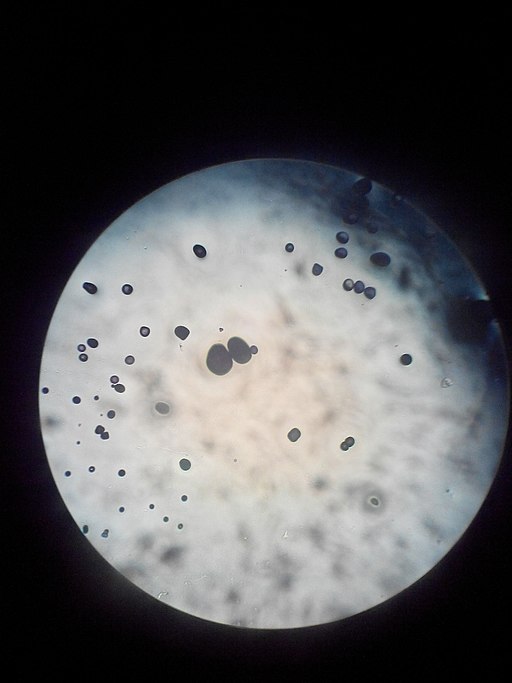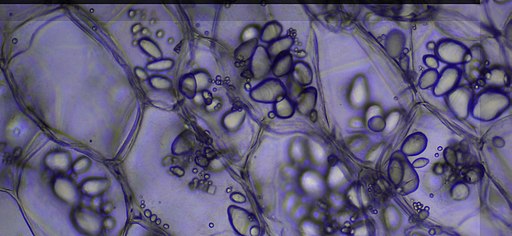Leucoplasts
** Types and Functions
What are Leucoplasts?
Like chloroplasts and chromoplasts, leucoplasts are a type of plastid only found in plant cells. As such, they can be used to distinguish between a plant and animal cell.
Unlike chromoplasts, leucoplasts do not have a color pigment and are therefore colorless. They are commonly found in storage tissue and are primarily involved in the storage of starch, lipids, and proteins. Aside from storage, leucoplasts have also been shown to play a role in the biosynthesis of several compounds.
There are three types of leucoplasts including:
- Amyloplast
- Elaioplast
- Proteinplast
Leucoplast Formation
Like chloroplasts, leucoplasts originate from cytoplasmic bodies known as proplastids.
Generally, the process starts with an increase in the number of ribosomes in the proplastid (these ribosomes are not attached to any membrane). This is followed by ingrowth of the inner membrane resulting in the formation of membrane vesicles or membrane tubules. However, it's not until the stromal vesicles begin to darken that the leucoplast starts developing.
As the plastid continues to develop, the increase in ribosomes stops, and those that already exist are altered. They do not exhibit the 70 S organizational structures that exist in younger proplastids.
Though the degradation of ribosomal structure is likely to occur in the early stage, this is not the case with DNA nucleoids. Even as the ribosome continues to degrade and disappear, young leucoplasts enlarge with a visible constriction which results in an irregular shape (most will assume a bell shape). This is accompanied by an expansion of the internal membrane as well as the development of interconnected tubules (starch granules also start to accumulate).
When viewed under the microscope, the remaining ribosomal structures are irregularity scattered or clustered within the stroma. The leucoplast continues enlarging and dividing, by budding at the constricted region, while the cell develops and divides.
In fully differentiated cells, a state that marks the last stage of leucoplast development, the tubular complexes (electron-dense), vesicles, and invaginations that are associated with the inner membrane disappear. Fully developed leucoplasts vary in shape and size.
Amyloplast
Amyloplast is one of the best-studied plastids. It's a type of leucoplast primarily involved in the synthesis and storage of starch (the word Amylo means starch).
They can be found in different types of plant cells including those found in the tubers, root caps, and storage tissues, as well as the cotyledon. In addition to the synthesis and storage of starch, amyloplasts are also believed to play an important role in graviperception (gravity sensing) in the roots.
The formation of amyloplasts occurs through a series of steps aligning with the development and differentiation of the cell. They are characterized by a double lipid membrane (inner and outer envelope) and measure between 20 and 45 um in diameter.
Based on a study aimed at investigating the formation and development of the plastid, the addition of lovastatin in F-medium (enriched seawater medium) was shown to promote the development of amyloplasts as well as the accumulation of starch.
* Amyloplasts have been shown to originate from proplastids. They also divide through a process known as binary fission.
As amyloplasts develop, starch is produced and stored in the stroma (the matrix space). The carbohydrate is stored in the form of particles (starch grains). Depending on the type and part of the plant, these grains vary in size and morphology. Generally, starch stains are divided into two main categories based on morphology; compound or simple.
The compound grains are formed through the assembly of small granules as they aggregate together. The size and shape are largely dependent on the type of plant.
In the endosperm of rice, for instance, the compound grain of starch varies between 10 and 20 um in diameter. These grains are typically characterized by granules in the form of shard polyhedral edges that measure between 3 and 8 um in diameter. Each simple starch grain, on the other hand, is a single granule. They are commonly found in several types of plants including main, barley, and wheat.
There are two main types of simple grains namely, bimodal and uniform. Generally, bimodal simple grains include B-type starch grains (smaller simple starch grains) and A-type starch grains (larger simple starch grains). Uniform grains vary in shape from round to pentagonal and hexagonal.
The A-type granules, which are larger in size, are found in the body of the plastid (Amyloplast). B-type granules are smaller in size and initially located in amyloplast protrusions known as stromules.
* Most of the intracellular space of amyloplasts is occupied by starch. Therefore, the size of the starch grain can be used to estimate the size of the plasmid.
Starch Synthesis and Storage in Amyloplasts
Starch is synthesized and stored in both chloroplasts and amyloplasts. However, amyloplasts (mostly found in seeds e.g. wheat grains) generally contain more starch granules than chloroplasts.
Unlike chloroplasts, amyloplasts do not have thylakoids and stroma lamellae. For this reason, they have more room to store starch. Seeds also contain many amyloplasts given that they need all the energy available for growth. This is also the reason roots, like seeds, contain many amyloplasts.
* Chloroplasts contain transitory starch while amyloplasts contain reserve starch.
In both chloroplasts and amyloplasts, the enzymes ADP-glucose pyrophosphorylase (ADP-Glc PPase), branching enzyme, and starch synthase are responsible for the synthesis of starch.
Generally, the process starts with a catalytic reaction that converts glucose-1-phosphate to ADP-glucose. The enzyme ADP-glucose pyrophosphorylase is involved in this reaction. The glucose (ADP-glucose) is then converted to a starch molecule by the addition of glucose units at the end of the growing polymer chain.
Here, the enzyme starch synthase is responsible for adding glucose units to the ADP-glucose molecule, a process that releases the ADP. Lastly, starch branching enzymes are involved in introducing branches to the chain. Specifically, the enzyme serves to hydrolyze the 1, 4-glycosidic bonds and replace them with 1, 6 bonds.
Amyloplasts and Gravitropism - As mentioned, amyloplasts are also thought to play an important role in gravitropism. Essentially, gravitropism refers to the coordinated process that directs plant growth in response to gravity. As starch accumulates in the amyloplast (in the roots), this causes the amyloplasts to sediment in the plant tissue thus influencing a downward growth of roots (in the direction of gravity).
Elaioplast
Elaioplast is a type of leucoplast involved in the storage of oil/lipids (in the form of triacylglycerol and sterol esters and monogalactosyl-diacylglycerol). They are generally small in size, about 2.15um in diameter, and round/spherical. In addition to the lipid droplets, studies have shown these plastids to also contain some protein.
Elaioplasts can be found in different parts of the plant where lipids would be more ideal for energy storage as compared to starch. For instance, they can be found in abundance in tapetum cells (nutritive cells located in the anther) of the anthers. In this particular region of the plant, elaioplasts contain high amounts of neutral esters that become part of the wall of the pollen grain when the plastid disintegrates.
* The word "elaiov" is a Greek word for olive.
* Elaioplasts are specialized chloroplasts. Unlike chloroplasts, however, they lack thylakoids and contain lipid droplets.
Proteinoplast
Also known as aleuroplasts, proteinplasts are commonly found in plant seeds and are involved in the storage of proteins. Generally, all plastids contain some level of protein.
Proteinoplast contain larger and more visible inclusions (crystalline or amorphous protein inclusions). Collectively, these proteins are known as seed storage proteins (SSPs). They are different from vegetative storage proteins (VSP) in that they accumulate in the proteinoplasts of seeds during the late stage of seed development. As such, they play an important role in seed germination. They are broken down to amino acids to meet the nutritional needs of the developing seedling.
These proteins also make up the primary proteins found in grains (proteins that are mostly consumed by human beings).
* Seep storage proteins supply the germinating seed with nitrogen and sulfur required for development.
General Characteristics of Leucoplasts
As mentioned, leucoplasts are abundant in plant roots and non-photosynthetic tissue. Here, they are primarily involved in the storage of proteins, starch, and lipids. In many other cell types, however, they play a crucial role in the biosynthesis of these molecules.
Compared to chloroplasts, they are smaller in size with variable morphology. Epidermal cells of roots, petals, and callus among a few other tissues, are connected by narrow tubular structures known as stromules. At a given stage of cell development (in certain cells, e.g. cells of the root meristem), leucoplasts can be seen clustering around the nucleus.
In such cases, the stromules often extend into the cell periphery and may be involved in the biosynthetic process. In wheat, for instance, the extension of amyloplast stromules is associated with the formation of starch granules. Specifically, the stromules act as the site of B and C type starch granule formation.
* In some parts of a plant (e.g. meristematic region of rhizome), elaioplasts have been shown to be pleiomorphic and can transform into specific organelles.
More plant biology related articles:
Leaf Structure under the Microscope
Difference between an animal cell and a plant cell
Return from Leucoplasts - Types and Functions to MicroscopeMaster home
References
Cheniclet, C. and Carde, J. P. (1988). Differentiation of Leueoplasts: Comparative Transition of Proplastids to Chloroplasts or Leueoplasts in Trichomes of Stachys lanata Leaves.
Chu, C. and Li, H. (2015). Protein import into isolated pea root leucoplasts. https://www.ncbi.nlm.nih.gov/pmc/articles/PMC4560022/
Pyke, K. (2009). Plastid Biology.
Links
Find out how to advertise on MicroscopeMaster!






